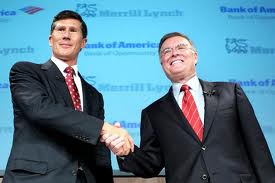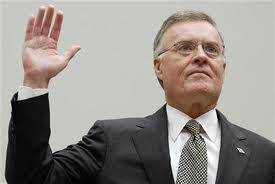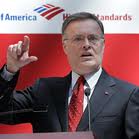Is Bank of America Worth $200 Billion?
First posted April 9, 2009… Re-posted now at reader’s request…
And a good idea because its worth reading. Nothing’s changed.
Just for the record, I did study accounting, both at the undergraduate and graduate levels. I’m no accountant, by any means, but if you explain it to me slowly, I can usually “get it”.
I understand quite a bit about the public company structure and tax treatment associated with the informal funding of previously unfunded, long-term liabilities associated with nonqualified executive benefit programs, the importance to the P&L of asset to liability “matching” on corporate balance sheets and even how to balance my business checking account… well, sort of… no one can actually balance today’s business checking accounts.
Anyway, I’m not bragging, I’m just saying. That’s it. I just wanted to say that. Now, I’ll start writing the article whose headline drove you to read. Okay, sorry… so here goes…
Yesterday, Oppenheimer issued a report saying that Bank of America would need to raise an additional $36.6 billion dollars to bring its capital ratios in line with its competitors, Fox Business Network reported. Bank of America denies it.
Whew! Well, I for one am so totally relieved. Or, at least I would be… if I could make myself believe even one word of what comes out of CEO Ken Lewis’ mouth. Why does this guy still have a job? I’m serious, why?
President Obama told GM’s CEO to hit the bricks, but I liked the guy. Why? I don’t know… because I have a GM Suburban, it’s my second one… they run great… comfortable… four wheel drive… safe… I know… lousy gas mileage, but you never hear me complaining about it. GM’s CEO had been there forever, and was working for a dollar a year. Why call for his head and then put his #2 at the helm? Please don’t tell me that you’re expecting me to believe that the #2 guy at GM is radically different than his boss of the last umpteen years. I mean it… don’t tell me you want me to believe that, because that’s just stupid.
Remember when Lewis was talking about the downfall of those other banks and saying that it represented an opportunity for Bank of America to assume its rightful position as the clear and dominant leader of the banking industry. Lewis was like a cat perched above looking down coyly at the silly humans and their problems. When was that… hmmm… oh yeah, like six months ago, which is about a decade in deepening-recession-hours.
Bank of America bought Countrywide for $4 billion and change. That sounds funny to me now. You’ve got to admit it. The idea that someone would PAY money for Countywide has to make you giggle at least a little bit. Like someone buying themselves rheumatic fever. Shouldn’t Countrywide have been free? Never mind… I’m just saying.
Then, adding insult to injury, the man paid money for Merrill Lynch, too. And I think that makes him a special kind of moron. He’s a moron with hubris… you know… brass balls, you’ll pardon the phrase.
Without getting overwhelmed in details, let’s take a look at a few highlights from Mr. Lewis’ recent past, shall we?
Back in the latter part of January 2008, the Federal Reserve announced an emergency rate cut. Mr. Lewis called it a “pleasant surprise,” according to Reuters, saying that the move should help stave off a recession. Here’s what Lewis said at the time:
“It was a bold and decisive move and was exactly what the market needed. Growth had become very sluggish. Absent any moves, we were very close to a recession. This gives us a chance not to have one.”
Now, it’s important to keep in mind that he was saying this in late January 2008, and Bank of America had just reported fourth quarter 2007 results. The bank’s filings, which were signed by Mr. Lewis, showed net income tumbled 95% to 5¢/share from $1.16/share just one year ago. They also showed the bank writing off $5.28 billion in collateralized debt obligations (CDOs). Merrill alone had $16 billion in write-downs that last quarter of 2007, and posted a $9.8 billion loss.
I wonder what set of factors would have to occur for Mr. Lewis to see the potential for a recession ahead.
“Sir, it is Armageddon out there… has been Armageddon for months now. What shall I tell the press?” “Tell them I still think the resilience of the American workforce combined with the entrepreneurial spirit of our young people, will once again prove and let the world see, how our economy is strong… blah, blah, blah.” I can hardly listen to these guys anymore.
Fast-forward to early October 2008, again according to Reuters, and you’ll find a very different picture.
“These are the most difficult times for financial institutions that I have experienced in my 39 years in banking,” said Kenneth Lewis, its chairman and chief executive officer, in a statement.
Bank of America warned that credit quality continued to weaken during the quarter, and Lewis said he expected higher credit losses and depressed earnings ahead. Third-quarter net income dropped to $1.18 billion, or 15 cents a share, from $3.70 billion, or 82 cents a share, a year ago.
Lewis blamed the weaker earnings on higher credit costs resulting largely from Countrywide Financial Corp and Chicago-based LaSalle Bank, its two most recent acquisitions. The bank cited “recessionary conditions,” and halved its dividend on October 6, 2008.
October 6, 2008? Wasn’t the whole Wall Street meltdown thing around September 15th? Ask Sen. John McCain, I’m pretty sure he’ll remember the exact date. Maybe even the time.
Fast-forward again to January 16, 2009 and you find a joint press release from the Federal Reserve Board of Governors, the FDIC, and the Treasury Department. It reads:
The U.S. government entered into an agreement today with Bank of America to provide a package of guarantees, liquidity access, and capital as part of its commitment to support financial market stability. Treasury and the Federal Deposit Insurance Corporation will provide protection against the possibility of unusually large losses on an asset pool of approximately $118 billion of loans, securities backed by residential and commercial real estate loans, and other such assets, all of which have been marked to current market value. In addition, Treasury will invest $20 billion in Bank of America from the Troubled Asset Relief Program.
Then a week or so ago, Bloomberg reported that:
Bank of America Corp is carrying loans on its balance sheet marked at more than $44 billion above their fair value, the company said in its annual report filed with U.S. regulators on Friday.
The bank said it ended 2008 with $886.2 billion in loans, but estimated the fair value – or market price – for these loans as $841.6 billion.
So far, so good? Are you keeping some lose track of all these numbers? You don’t have to run tape or anything, which is what us older folk used to call using a calculator when it was still an adding machine, just so you have some sense of the dollars involved is fine.
The other thing I don’t like about Ken Lewis, is that he bought Countrywide… which means he had to get along with Angelo Mozilo, who is shaping up fast to be the Ken Lay of the mortgage meltdown. As I understand it, the competition for the Ken Lay moniker is stiff this year, but smart money is still backing Mozilo.
Countrywide was the nation’s largest predatory lender… er… I mean sub-prime mortgage lender. It’s been investigated by the FBI, SEC, and God only knows who else, but I’m not even talking about any of that. I’m talking about Mozilo. He’s the guy who gave us IndyMac Bank, now IndyMac Federal. It was like someone pulling the pin on a grenade and handing it to you. You turn around and… KA-BLAMO!
Of course, with the meltdown in full swing in late 2006 and throughout 2007, Mozilo sold $145 million in Countrywide stock. Simply put, he is a man who made hundreds of millions of dollars while the mortgage market fell apart and people lost their homes, dreams, and life savings. My kind of guy he is not.
Look, I don’t care about being politically correct here, the guy’s a crook. He needs to give the money back and go to jail. His is the kind of case that really shouldn’t take more than an hour or two to get through at trial. What’s to discuss? The prosecution could just stand up and say, “Ladies and Gentlemen of the jury, we are here to punish Angelo Mozilo,” and then sit back down. Then the foreman could stand up and say, “We have reached a verdict, Your Honor.” And… cut… print… that’s a wrap people, the Final Four are on… ”
 (Ow, ow… take it easy, John… ow, ow, ow.)
(Ow, ow… take it easy, John… ow, ow, ow.)
So, Lewis made a deal with Mozilo and the guy from Merrill Lynch, who bought the antique toilet for like $36,000 or some crazy number. Now, what kind of person do you have to be to ever come in contact with, much less consider or purchase an antique toilet for $36,000… or $360 for that matter? (For $36, I might buy it.) That’s not the thinking of a normal mind, right?
I’d be walking along with the antique dealer and he’d say to me: “Well, and right over here we have an antique toilet for $36,000.” And I’d go: “Ooooo, yuck… that’s disgusting. Throw it away. $36,000? What… are you on crack?”
The Royal Tushie.
Mr. Kenneth Lewis, CEO of Bank of America, however, must have gotten along with both these guys… a very sleazy group, if you ask me. And we, the tax payers have now given Bank of America roughly $164 billion in order to keep it not lending to businesses or consumers.
So, now even though old Kenny-boy says it’s not true about Bank of America needing another $36 billion, the chances of him telling the truth are small enough, but since it’s Lewis we’re talking about here, I should add that the chances of him knowing or actually being right are so slim that it’s not even worth talking about.
So… I suppose we’re going to give Bank of America the $36 billion… and who knows what we’ll cough up after that. There’s no reason to think that Bank of America is going to get better… ever. You can’t expect a company to digest that many toxic assets and live. Look for the announcement on page 16B of the Business Section on a Saturday.
Once we’ve said yes to the additional $36 billion, we will have come up with $200 billion for BofA including guarantees and cash.
I stared at the number for a few minutes and finally couldn’t contain myself… I had to know. I went online to find out how much Bank of America is worth… as a company… if we bought the damn thing. It wasn’t at all difficult to find out. Couple of clicks and there it was. As of a couple of weeks ago, Bank of America had a valuation of… wait for it… a little less than $30 billion.
That $30 billion includes the bank’s stakes in Central, South American banks, and asset manager Blackrock, which came with the Merrill Lynch acquisition. Add to those holdings the bank’s stake in China Construction Bank, currently valued at $20 billion, and you get a total price tag of $30 billion for Bank of America. And we’re paying $200 billion… but we don’t own the bank?
How the hell do accountants do it? The Citibank deal was a lot like this one. We pumped so much money into Citibank relative to its value that when Secretary Geithner announced on a certain Monday morning that the US government would nationalize Citigroup, it would invest with a partner, and the US taxpayers would only own 36%… after pumping hundreds of billions into it.
 All about transparency, yeah… that’s the ticket.
All about transparency, yeah… that’s the ticket.
I know, I know… it’s not all going into common shares, which are technically the shares that own and control the company through the election of its Board of Directors. But so what? I’m tired of struggling with the accounting related to this mess. It would seem that it’s long past time for a little common sense.
If you pump $200 billion into something with $30 billion and don’t own it… then all bets are off. Up could be down… in might be out. Don’t ask me nothing… I obviously don’t know a thing under such conditions. Whatever accounting classes I took were clearly a waste of time because I’m out of the field. Don’t want to know… not going to ask…
Oh, and one last point… one small, little, minor point I just read about… it’s the one that ultimately caused me to have to lie down.
On a national basis, the Wall Street Journal reported earlier this month that banks hold $41 BILLION in LOANS MADE TO TOP EXECUTIVES, DIRECTORS, AND OTHER INSIDERS!
At Charlotte-based Bank of America, those loans more than doubled last year, to $624.2 million – the biggest dollar jump in the country. The largest of them likely went to three directors or their companies. The surge came during the third quarter as credit markets froze, the government prepared to infuse banks with billions in tax dollars and the board approved the purchase of troubled Merrill Lynch. Bank of America ranked fourth on the list of biggest insider lenders.
Industry experts were quoted as saying that insider lending is “particularly troublesome because it could cloud the judgment of people charged with protecting shareholders and overseeing bank management.” Particularly troublesome? I’ll bet they’re particularly troublesome.
And wouldn’t you know it… at Charlotte-based Bank of America, those insider loans more than doubled last year, to $624.2 million – the biggest dollar jump in the country and Bank of America ranked fourth on the list of biggest insider lenders… that’s my Kenny! I bet he makes his mother proud.
By the way, banks, as it turns out, don’t have to explain increases in insider lending. They don’t have to disclose individual amounts loaned or the terms of those loans to any insiders, including executives. Of course, insider favoritism is against the law, so we dodged a bullet there, don’t you think?
Most publicly traded companies were banned from making insider loans in 2002, as part of the regulatory changes that followed the Enron debaucle. But banks were excluded from the ban, because they’re banks, silly… and also because it was said that loans have been subject to extensive regulation for more than 25 years. That’s rich… really rich.
Here’s the rub…
Seventy percent of the banks with the largest insider loan balances got a more than $50 billion in the TARP funds late last year, according to an analysis of banks’ federal filings by the Charlotte Observer. What’s that you say? You don’t subscribe to the Charlotte Observer? Well, then you just won’t ever know these kinds of things I suppose. (To subscribe to the Charlotte Observer, call 1-800-EAT-SH#T.)
There’s a handbook called “Insider Activities” that’s published by the nation’s lead regulator for big national banks, the Comptroller of the Currency. Here’s what it says about insider loans at banks:
“Studies of bank failures have found that insider abuse, including excessive or poor quality loans made … is often a contributing factor to the failure.”
Did you feel that? We just got bitch-slapped across the face.
Good thing I don’t live near any bridges, ’cause I swear there are certain articles I write after which I just want to…
Mandelman out.








